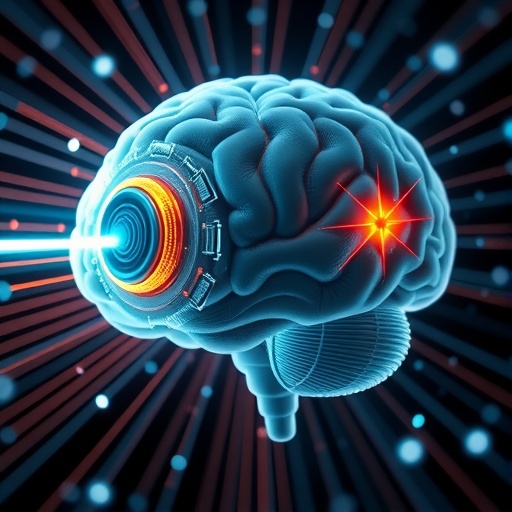In a groundbreaking advancement poised to revolutionize neuromodulation therapies, researchers at MIT have engineered microscopic, wireless bioelectronic devices capable of autonomously traversing the vascular system to self-implant precisely within targeted brain regions. This novel technology promises to transform treatment paradigms for a spectrum of debilitating neurological disorders by obviating the need for invasive brain surgeries traditionally required for implant placement. Through a seamless integration of cutting-edge electronics with living biological cells, these hybrids embody a new frontier in brain therapeutics, offering unprecedented precision, minimal invasiveness, and heightened biocompatibility.
The innovation hinges on minuscule electronic implants, diminutive in scale—each approximately one-billionth the size of a grain of rice—composed of intricately layered organic semiconducting polymers ensconced between metallic strata. Fabricated utilizing state-of-the-art CMOS-compatible processes within MIT.nano’s advanced facilities, these devices are subsequently liberated from their silicon substrates to exist as free-floating entities in solution. The transition from substrate-bound to free-floating proved formidable; an initial loss of electronic functionality persisted until the team successfully reestablished operational integrity after extensive experimentation spanning over a year.
Key to the operability of these bioelectronic hybrids is their remarkably efficient wireless power conversion capability. This advancement enables sufficient energy harvesting deep within cerebral tissue to facilitate targeted electrical stimulation. Importantly, the bioelectronic devices are chemically bonded to monocytes—immune cells intrinsically programmed to home in on inflamed tissue. This hybridization permits the implants to navigate the circulatory system stealthily, evade immune detection, and delicately transverse the blood-brain barrier (BBB) without compromising its essential protective function. This noninvasive crossing of the BBB marks a critical milestone in neurotherapeutics, expanding the potential reach of electronic intervention beyond previous limitations.
Once within the brain, the implants autonomously identify and embed themselves within inflamed regions, taking advantage of the monocytes’ intrinsic targeting capabilities. The integration enables the bioelectronic devices to provide exquisitely precise neuromodulation, stimulating neuronal circuits with micron-level exactitude. This spatial fidelity significantly surpasses that of conventional electrode-based systems, allowing millions of microscopic stimulation sites to conform precisely to the morphology of targeted brain areas. In parallel, extensive biocompatibility assessments affirm that these diminutive devices co-exist harmoniously with neuronal populations, eliciting no discernible adverse effects on cognitive or motor functions.
The researchers demonstrated this technology’s efficacy in murine models, employing fluorescence tagging to track cellular migration and bioelectronic implantation through the BBB. Electrical stimulation was delivered wirelessly via externally applied near-infrared electromagnetic waves, which the implants adeptly harvested and converted to bioactive signals. This modality of neuromodulation showed promise in attenuating localized brain inflammation—a pathogenic hallmark implicated in numerous neurodegenerative diseases such as Alzheimer’s disease and multiple sclerosis.
Beyond focusing on neuroinflammation, the MIT team envisions adaptable applications leveraging different immune or neural cell types engineered to target discrete brain regions. Such versatility could enable personalized therapeutic regimens for an array of brain maladies, including glioblastoma and diffuse intrinsic pontine glioma (DIPG), where multifocal tumor sites or surgically inaccessible locations currently frustrate conventional treatments. The technology’s capacity for widespread deployment of intricately distributed microsites holds promise for comprehensive tumor control and functional restoration.
The hybrid cell-electronics platform exemplifies an elegant synthesis of biological transport mechanisms with sophisticated nanoelectronics, yielding a system capable of long-term brain residence without provoking immune rejection. This quality is paramount for chronic neurological interventions, where immune compatibility dramatically influences therapeutic durability and patient safety. Furthermore, the capability to deliver neuromodulation without surgical intervention could dramatically reduce healthcare costs and procedural risks, broadening patient access to advanced treatments previously limited to specialized centers.
Looking ahead, the team aims to augment these bioelectronic devices with integrated nanoscale circuits capable of sensing, on-chip data analysis, and feedback control, potentially enabling synthetic electronic neurons. This enhancement would foster dynamic interaction with neural networks, embodying a true brain-computer symbiosis. Such advancements could herald a new era in neuroprosthetics and neural rehabilitation, pushing the boundaries of human-machine interfacing.
Encapsulating years of interdisciplinary collaboration, the researchers have already laid the groundwork to transition this promising technology toward clinical application. Through the establishment of Cahira Technologies, a startup dedicated to advancing circulatronics, efforts are underway to initiate human trials within the next three years, prospecting the transition from murine models to therapeutic realities for patients afflicted by intractable neurological diseases.
The convergence of nanoelectronics, immunology, and neuroengineering in this cell-electronics hybrid strategy exemplifies transformative potential in biomedical science. By enabling minimally invasive, high-precision brain stimulation, this technology may soon afford novel treatment avenues for conditions that presently elude effective intervention, heralding a paradigm shift in neuroscience and clinical neurology.
Subject of Research: Non-surgical brain implants integrating cell-electronics hybrids for targeted neuromodulation.
Article Title: “A non-surgical brain implant enabled through cell-electronics hybrid for focal neuromodulation”
News Publication Date: Information not provided in the original text.
Web References: https://orbit.mit.edu/launchpad/ideas/cahira-technologies
References: Published in Nature Biotechnology.
Keywords: Bioengineering, Electronics, Cells, Brain, Neuromodulation, Blood-Brain Barrier, Wireless Power Transfer, Organic Semiconductors, Immune Cell Targeting, Brain Inflammation, Neurodegenerative Diseases, Nanoelectronics
Tags: advanced CMOS fabricationbiocompatible electronic implantsbrain implantsenergy harvesting in brain implantsminimally invasive neurosurgeryMIT research innovationsneurological disorder therapiesneuromodulation therapiesnon-invasive brain treatmentsrevolutionary medical technologytargeted brain regionswireless bioelectronic devices





